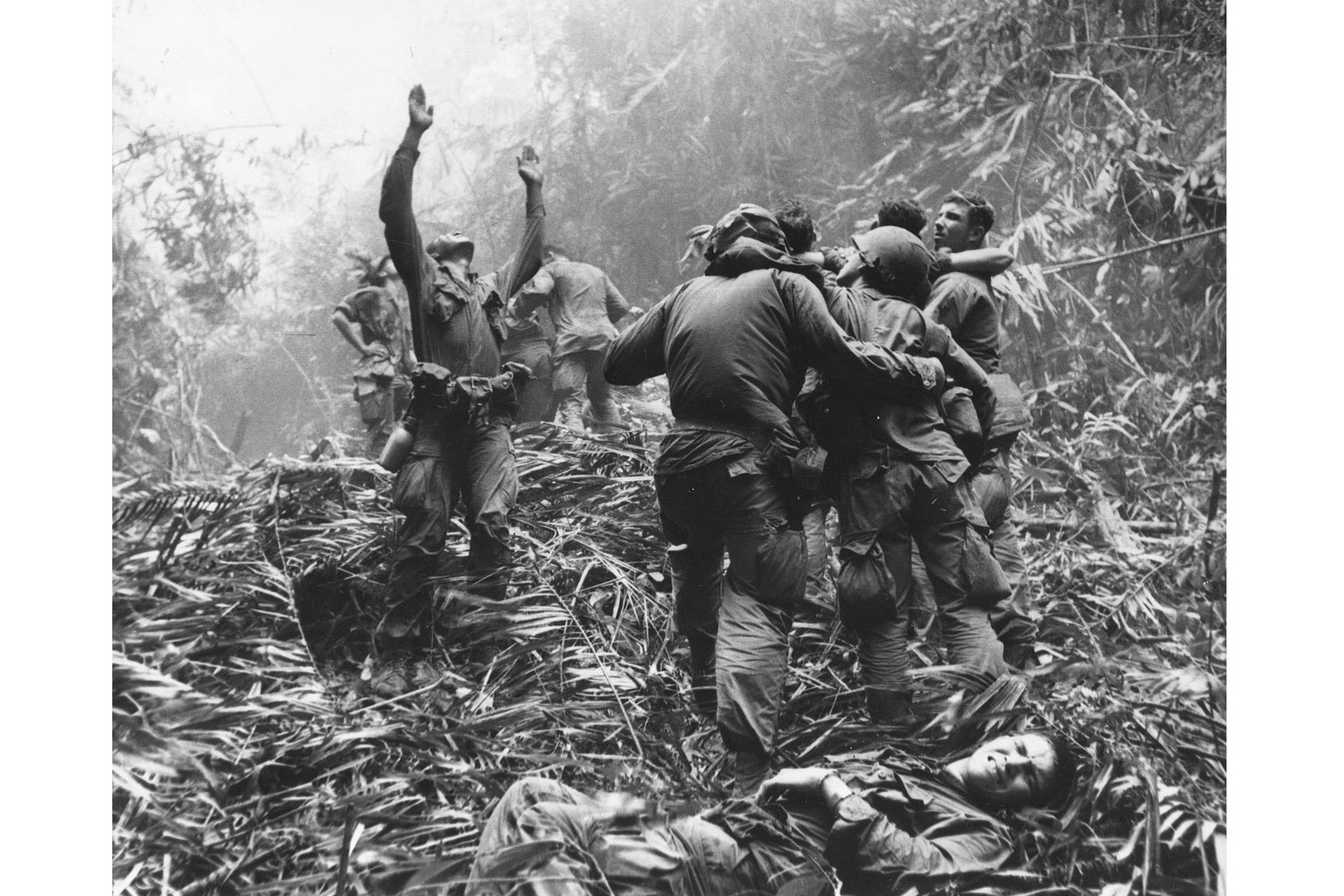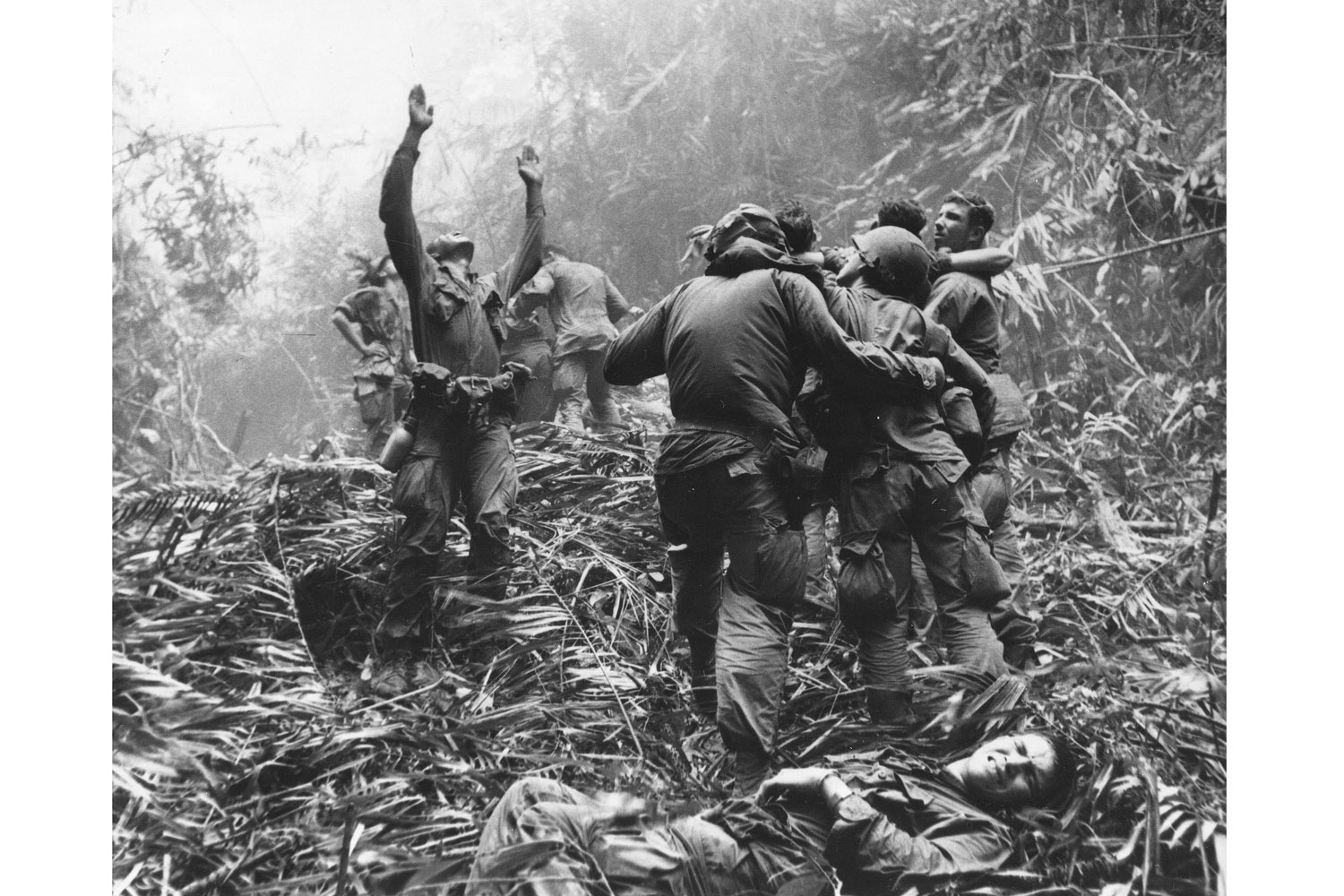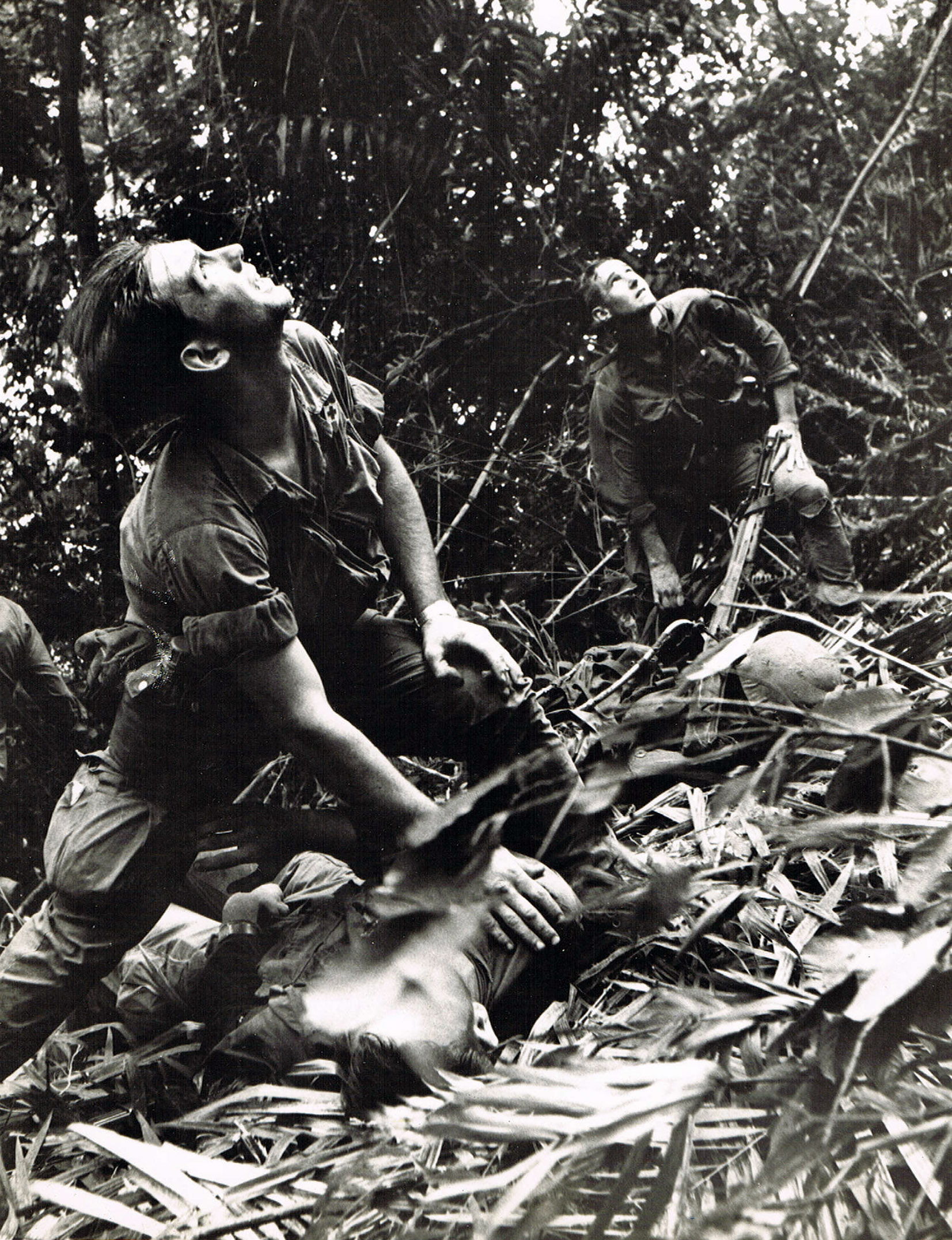
Like the soldiers he was photographing, Art Greenspon was in his 20s when he traveled to Vietnam to document the war. After five months in-country, Greenspon went on a two-day patrol with soldiers in the A Shau valley, just inside the Laotian border. There, after an ambush and subsequent firefight, Greenspon made a photograph that David Douglas Duncan, the famous TIME-LIFE war photographer, lauded as the “best picture yet of the Vietnam War.”
One week after that fateful patrol, Greenspon was wounded when a spent shell hit him in the face. Greenspon returned to the U.S., worked as a photographer for the The New York Times, and transitioned to a successful career in finance.
But he wasn’t done. At the age of 69, Greenspon earned a masters degree in clinical social work with the goal of helping veterans. “I know how hard it is to recover from PTSD, trauma and addictions,” he says. “In the final years of my life, I am dedicated to helping troops recover from the horrors of war.”
TIME asked photographer Peter van Agtmael to speak with Greenspon about his career. Van Agtmael, age 32, has spent the past seven years documenting the United States’ extended conflicts in Iraq and Afghanistan as well as their affects back home. Their edited conversation appears below.
Peter van Agtmael: Tell us about your background. Why did you become a photographer?
Art Greenspon: My father had an old Zeiss Ikon he brought back from World War II. I loved it, but he would never let me use it. Instead he bought me a Kodak Brownie Hawkeye. I have fond memories of taking over the downstairs bathroom making contact prints under the red light we screwed in above the sink.
While I was working at WCBS-TV in New York I drove the old-time cameramen crazy asking them how their cameras worked and why they were shooting this or that angle. I was more interested in what they were doing than in some of the bullshit stories I had to cover. I quit the glamour job in TV news and took one as a darkroom assistant in a small commercial studio paying sixty dollars a week. I was happy as a clam!
Why did you go to Vietnam? Tell me a little bit about your time there before taking the famous picture.
The biggest news story in the mid-Sixties was Vietnam. On the weekends, I’d go out into the streets to shoot the protest and the support-the-troops demonstrations — but I always seemed to come away with better snaps of the “Support Our Boys” folks.
Every Memorial Day, my dad would take the whole family to see the parade in Bridgeport, Connecticut. His eyes would well up with tears every time an American flag went by. He obviously had been very moved by his own war experience and my brother and I had been raised to honor and respect our country and the men and women of the armed services. I had no strong personal feelings one way or the other on Vietnam at first, but I knew I would never find the “truth” at home. The truth was over there in Vietnam.
And Tim Page! He blew into my life, into everyone’s life, like a twister. Chain smoking, hard drinking, reefer madness personified. Sex, drugs and rock and roll — that was Page. And he liked my pictures! “Garspon” he nicknamed me. “You’ve got to go. I’ll introduce you to Bill Snead at UPI.” And Snead liked my pictures, too. “I can’t get you there” Snead told me. “But if you get to Saigon, you can string for us.”
I got $600 for my Volkswagen beetle, bought a one-way ticket to Saigon, got a 10-day tourist visa and set out to show the world “the truth” about Vietnam. I arrived on Christmas Day of 1967. I was too naive to be scared.
Bill Snead and some friends at CBS showed me the ropes. I spent a few weeks going out with various units without much success. But I turned in my film to Snead, and he bought three pictures, let me crash at the UPI barracks, and was OK with me taking the outs over to Horst Faas at AP. Faas bought another eight, so I was flush with $165 and a safe place to flop. And so it went. I would go north — Khe Sanh, Hue — come back with my film, sell pics, eat well, prowl the streets and alleys and then do it all over again. And I wasn’t alone. Page was there with Sean Flynn and Dana Stone and quite a cast of characters. As Mike Herr wrote in Dispatches, “Vietnam was what we had instead of a happy childhood.”
On the personal side, I was beginning to suffer. I was having more sleepless nights and intrusive thoughts of previous combat experiences. I would always sit with my back to a wall, and shudder at loud noises. These are all classic symptoms of Post Traumatic Stress. I had been covering lots of combat for three and a half months, and it was beginning to take a toll.
Under what circumstances did you take the picture? Can you tell me a little bit a bit about that day?
By April of 1968, I felt I had developed into an accomplished war photographer. I really enjoyed talking war and photography with Fass and Eddie Adams, and Larry Burrows from time to time. You need to understand that of the six hundred accredited journalists in country at the time, only about fifty of us went into the field on a regular basis. The rest got their stories at the military briefings, the “five o’clock follies,” as we called them. Many newsmen earned their stripes from inside Saigon’s gin mills and whore houses. We all knew who had balls and who didn’t, who cared about the grunts and who didn’t. It was a camaraderie that I have never again experienced.
The U.S. military had been embarrassed by the first Tet offensive, and several divisions of NVA were operating freely just inside the Laotian border in the hills surrounding the A Shau valley. In mid-April, High Command decided to airlift nearly the entire First Air Cavalry Division into those hills to drive out the NVA. As I hustled out of my chopper with Dana Stone and some TV crews, I was expecting heavy fire. But nothing — nothing but wave after wave of choppers and a swarm of journalists and photographers from around the world. I didn’t make a picture.
I jumped on an empty slick [supply helicopter] and headed back to Quang Tri city. I felt awful. Biggest operation of the war, and I get nothing.
I found my way to a PIO [public information office] and they told me several battalions from the 101st and 173rd Airborne Divisions were acting as a blocking force to the southwest of Hue. The aviation battalion supporting them was reporting heavy contact. Best of all, there were no other journalists out there. They were flying in ammo on a regular basis, and I was welcome to hitch a ride. But they warned me the weather was very bad, so they couldn’t guarantee I could get out when I wanted. That was fine with me.
It was about four in the afternoon when I got on the ground. We never really landed. I had to jump about six feet after they kicked out the ammo. It hurt hitting the ground with a 30-pound pack. But the landing zone wasn’t hot, thank God.
I found the CO and he briefed me. Alpha company, where I had landed, had been experiencing intermittent contact for several days. Charlie company, on the other hand, had been in nearly constant contact for nearly two days. It was getting dark and Alpha company planned to move down through the valley of elephant grass and then up the opposite hill to link up with Charlie company. The company first sergeant wasn’t shy about telling his superiors he thought the whole idea of moving through elephant grass full of NVA in total darkness was both suicidal and dumb.
After discussion of the pros and cons, the CO decided against moving out in the darkness. We moved out at first light, in total fog. We went into the elephant grass, which made the visibility worse. The first sergeant [the man with his arms raised in the photo] said he knew we would be ambushed and he was just glad he wasn’t walking point. Suddenly, chaos everywhere. Somebody pushed me to the ground from behind and held me down. I tried to crawl inside my helmet which was my usual first reaction to close-in combat. The bullets were whizzing through the grass, and I squeezed off maybe eight shots. Nobody near me dared fire. We couldn’t see more than three feet in any direction. The NVA fire lasted a minute or two. And then nothing. We were in it now, but nobody knew how bad it was going to be.
The man walking point was killed and the whole lead squad was decimated. After a few minutes of walking forward I came to where the wounded were being treated. I raised my Leica but the medic put his hand up and shook his head. This was bad, too many dead, too much loss too soon. I walked on.
We linked up with Charlie company, which had suffered heavy casualties. Nearly half the company had been killed or wounded. They were low on ammo, short on food and water and needed medical supplies. I wandered around handing out the cans of fruit I always had stuffed in my pack. I must have passed up 25 good pictures that day while troops were getting to know and trust me.
“Hey, camera guy,” they told me. “You don’t have to be here. You’re nuts, man.” I took pictures they wanted me to take. Buddies arm in arm and head shots for the local newspapers.
The weather was awful. Low dense fog, rain showers. Battalion told us no supply or medical missions were possible until the weather broke. We were alone on our hilltop in the middle of division-sized NVA units.
It rained hard that night and nobody slept. I was having trouble keeping my cameras dry.
Our challenge was to get the dead and wounded out. About two in the afternoon it started to brighten and a resupply slick was able to make a brief visual on us. We got ammunition first and then some medical supplies, but no food or water.
Battalion told us to be ready for a lift out of some of the wounded the following morning if the weather was better. I had powered milk in hot water for dinner that night. I had given everything else away.
By the next morning the wounded were being moved to the new LZ. I was making pictures. As the first medevac chopper hovered overhead I saw the First Sergeant with his arms in the air. I saw the medic shouldering wounded and then I saw the kid on his back in the grass. I have got to get all this in one picture, I thought. My heart was pounding. Was 1/60 fast enough? Screw it. Shoot pictures. I got three frames off, and the moment was gone.
I knew what was in the camera, but when I went to wind back the film, I couldn’t. The film in my Nikon had become stuck to the pressure plate from all the moisture. My Leica was soaked, too, and I wasn’t sure what kind of pictures it was producing.
The weather closed in again. I had given all of my food away so I didn’t eat for two days. I wrapped my cameras in a damp towel and put them in my pack. I guarded that pack like a mother hen.
I flew out with the second chopper loaded with body bags. A kid headed out for R&R and a floor stacked with KIAs [killed in action]. War sucks.
In Saigon, I told Fass what I had but I wasn’t sure my exposures were correct. I described the lighting as best as I could and we decided to push the Tri-X three stops. It wasn’t enough to save the elephant grass ambush pictures, and most of the hometown portraits were too thin to print. I’m grateful for what I got, but I’m still a little sad for what I lost. Mine was no lucky picture.
You were wounded about a week later in an incident that killed the photographer Charles Eggleston. After you recovered, did you continue to work in Vietnam?
On May 5, 1968, while on assignment for LIFE, I was shot in the face. A spent round which [likely] had just exited the hand of another photographer smacked into the left side of the bridge of my nose and burrowed its way into my left sinus cavity. The wound itself was not grave. The military surgeons took the round out in a dentist chair by breaking my cheekbone from inside my mouth. No facial scarring that way.
What nearly killed me was dysentery. They had to pack me in ice to lower my 106 fever. The cold made the pain in my face worse, but I kept it all inside. I was on a ward with GIs who had lost limbs and two who were in casts from head to toe.
Following my discharge, I tried to keep shooting, but my hands trembled so badly I couldn’t work my cameras. I knew it was time to get out.
LIFE paid my hospital bills and bought me a plane ticket home. The Vietnamese staff at the CBS bureau told me how to bribe my way through the exit visa process. I had been an illegal alien the whole time after my tourist visa had expired.
Psychologically, I was a basket case. All I wanted to do was smoke opium or get drunk.
What did you do after Vietnam? Did you remain a photographer?
John Morris, the picture editor at the New York Times, a man very familiar with stressed-out war photographers, hired me to do some vacation replacement work during the summer of 1968. In the fall, he hired me on staff. I worked for the Times from 1969-1971.
Channel 13 in New York hired me as a segment producer to develop essays using filmed stills for their avant-garde news program, “The 51st State.”
At the same time I had linked up with some artists and filmmakers who were doing single-frame animation of paste-up collages, but by 1975, nobody was making any real money. I was working part-time in a post production sound studio, and I even have a small credit for working on Barbara Kopple’s Oscar- winning documentary, “Harlan County USA.” One of the highlights of that period was a heated, drunken argument I had with Susan Sontag in a Greenwich Village bar over whether documentary photography depicts reality!
By 1976, I was tired of being broke. I wouldn’t do commercial photography and the film work I was getting was too irregular. I didn’t feel I had the talent to be an artist of any real distinction. I did want to get married and raise children.
I drove a cab, became a salesman, worked my way through night school at Fordham and, BA in hand, talked my way into a Wall Street training program. If I was going to go for bucks, I was going to go for big bucks!
I made a fair amount of money on Wall Street in 25 years as a portfolio manager for elite private banks. I retired in 2007.
At a reunion of Vietnam journalists some years ago, Horst Fass told the group we were standing in, “Greenspon did it right. He took one famous photograph and then became a proper businessman and lived happily ever after.” It wasn’t so easy.
You’re now a social worker advocating for better veterans’ mental health care. Why did you decide to work with veterans?
I got my masters degree in clinical social work in 2011 at the age of 69. I know personally how hard it is to recover from PTSD, trauma and addictions. The military’s suicide rate is the highest it has ever been. It has been estimated that something like 20 percent of our vets are coming home with some form of mental distress. Unfortunately, less than half of them are getting the help they need. In the final years of my life, I’m dedicated to helping them recover from the horrors of war.
After years of thinking about what a photograph is I’ve concluded that, for me, it’s a snapshot taken with a Brownie Hawkeye. For decades I’ve been trying to unlearn my knowledge of photography, to recapture the spontaneity and simplicity I had in my early pictures. I will know it when I see it, but so far it has eluded me.
Peter van Agtmael is a photographer represented by Magnum. In 2012, van Agtmael received the W. Eugene Smith Grant in Humanistic Photography.
Vietnam: The Real War is available through Abrams. An exhibition of the images from the Associated Press’ book will open at Steven Kasher Gallery in New York on Oct. 24, 2013.


More Must-Reads From TIME
- The 100 Most Influential People of 2024
- How Far Trump Would Go
- Scenes From Pro-Palestinian Encampments Across U.S. Universities
- Saving Seconds Is Better Than Hours
- Why Your Breakfast Should Start with a Vegetable
- 6 Compliments That Land Every Time
- Welcome to the Golden Age of Ryan Gosling
- Want Weekly Recs on What to Watch, Read, and More? Sign Up for Worth Your Time
Contact us at letters@time.com